MBA Data Analysis and Content Analysis Report: Assessment 1, LB5235
VerifiedAdded on 2023/04/17
|15
|1825
|314
Report
AI Summary
This report presents a comprehensive analysis of data, addressing the requirements of an MBA assessment. The first part involves data handling, descriptive analysis, and the application of various statistical tests using SPSS. The analysis includes summarizing metric and non-metric variables, creating visualizations like pie charts and histograms, and exploring relationships between variables using scatter plots. Furthermore, the report conducts hypothesis testing to determine significant differences between exam grades, paper grades, and IQ levels. The second part of the report focuses on content analysis of interview transcripts, identifying common themes related to rewards, punishment, workplace culture, and the application of school knowledge. The report then discusses the relationships between these themes and provides a detailed interpretation of the findings. The study uses statistical methods and qualitative analysis to explore the data and derive meaningful conclusions.

Running head: Basic Analysis (MBA)
1
Student
Institution
Course
Date
1
Student
Institution
Course
Date
Paraphrase This Document
Need a fresh take? Get an instant paraphrase of this document with our AI Paraphraser
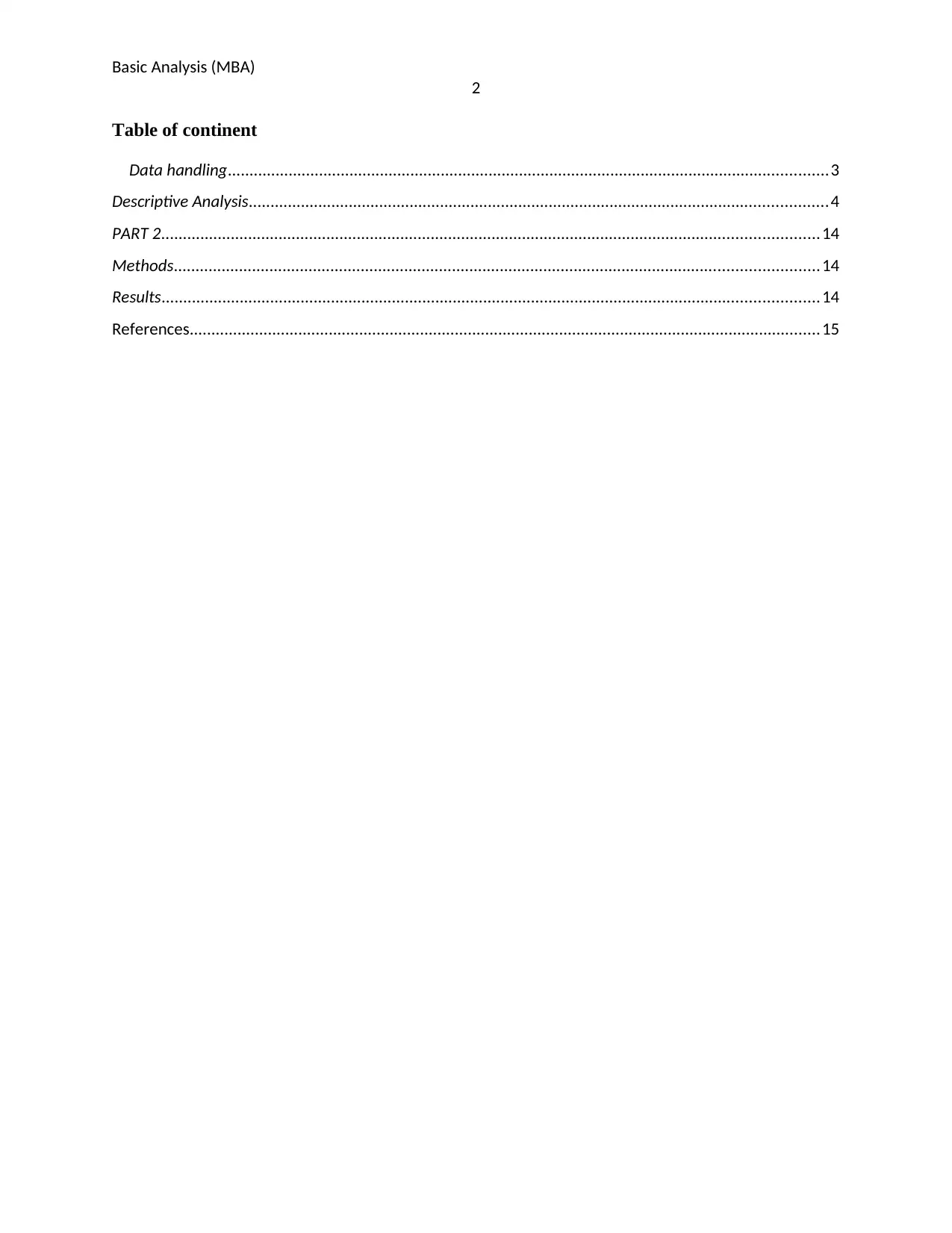
Basic Analysis (MBA)
2
Table of continent
Data handling..........................................................................................................................................3
Descriptive Analysis.....................................................................................................................................4
PART 2.......................................................................................................................................................14
Methods....................................................................................................................................................14
Results.......................................................................................................................................................14
References.................................................................................................................................................15
2
Table of continent
Data handling..........................................................................................................................................3
Descriptive Analysis.....................................................................................................................................4
PART 2.......................................................................................................................................................14
Methods....................................................................................................................................................14
Results.......................................................................................................................................................14
References.................................................................................................................................................15
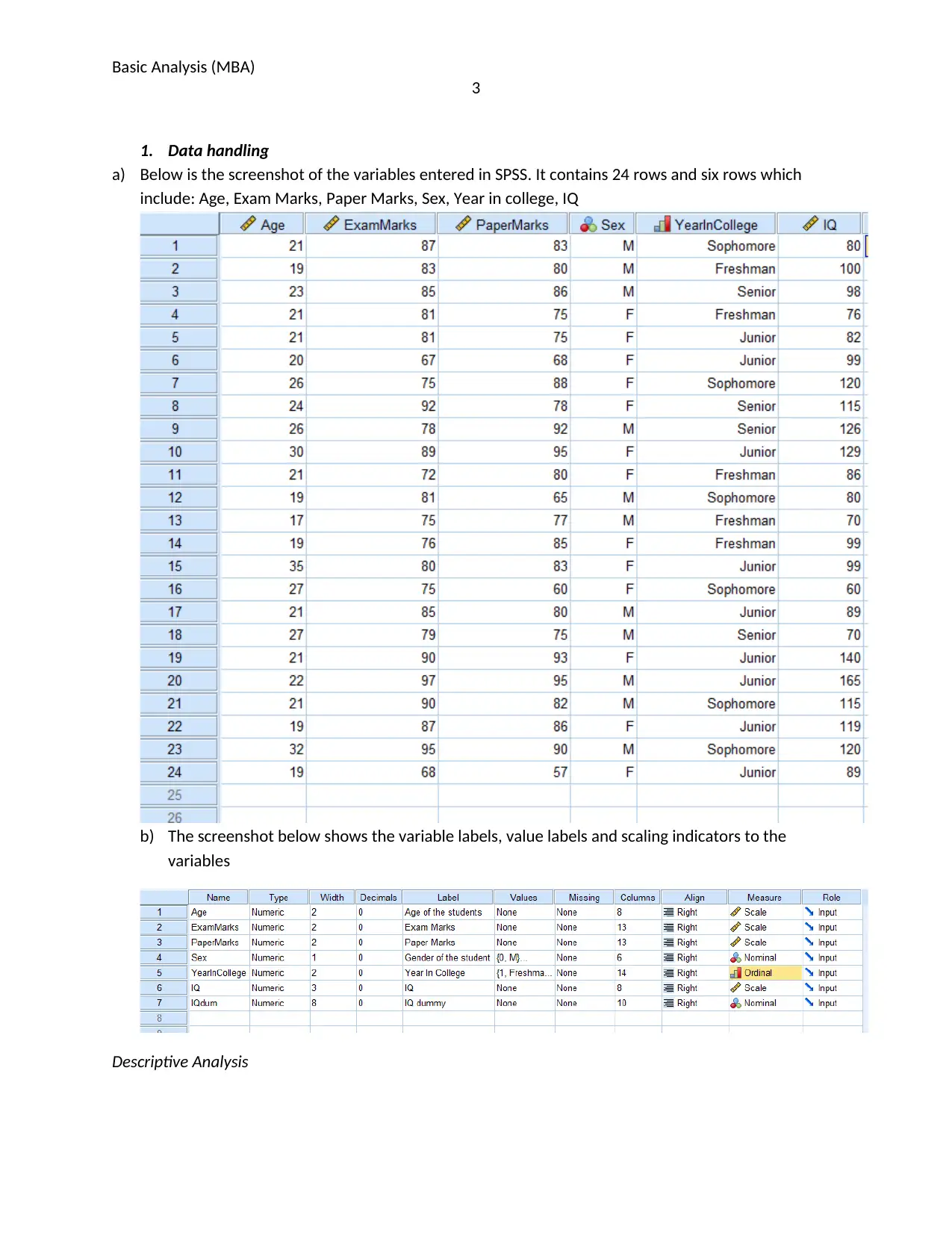
Basic Analysis (MBA)
3
1. Data handling
a) Below is the screenshot of the variables entered in SPSS. It contains 24 rows and six rows which
include: Age, Exam Marks, Paper Marks, Sex, Year in college, IQ
b) The screenshot below shows the variable labels, value labels and scaling indicators to the
variables
Descriptive Analysis
3
1. Data handling
a) Below is the screenshot of the variables entered in SPSS. It contains 24 rows and six rows which
include: Age, Exam Marks, Paper Marks, Sex, Year in college, IQ
b) The screenshot below shows the variable labels, value labels and scaling indicators to the
variables
Descriptive Analysis
⊘ This is a preview!⊘
Do you want full access?
Subscribe today to unlock all pages.

Trusted by 1+ million students worldwide
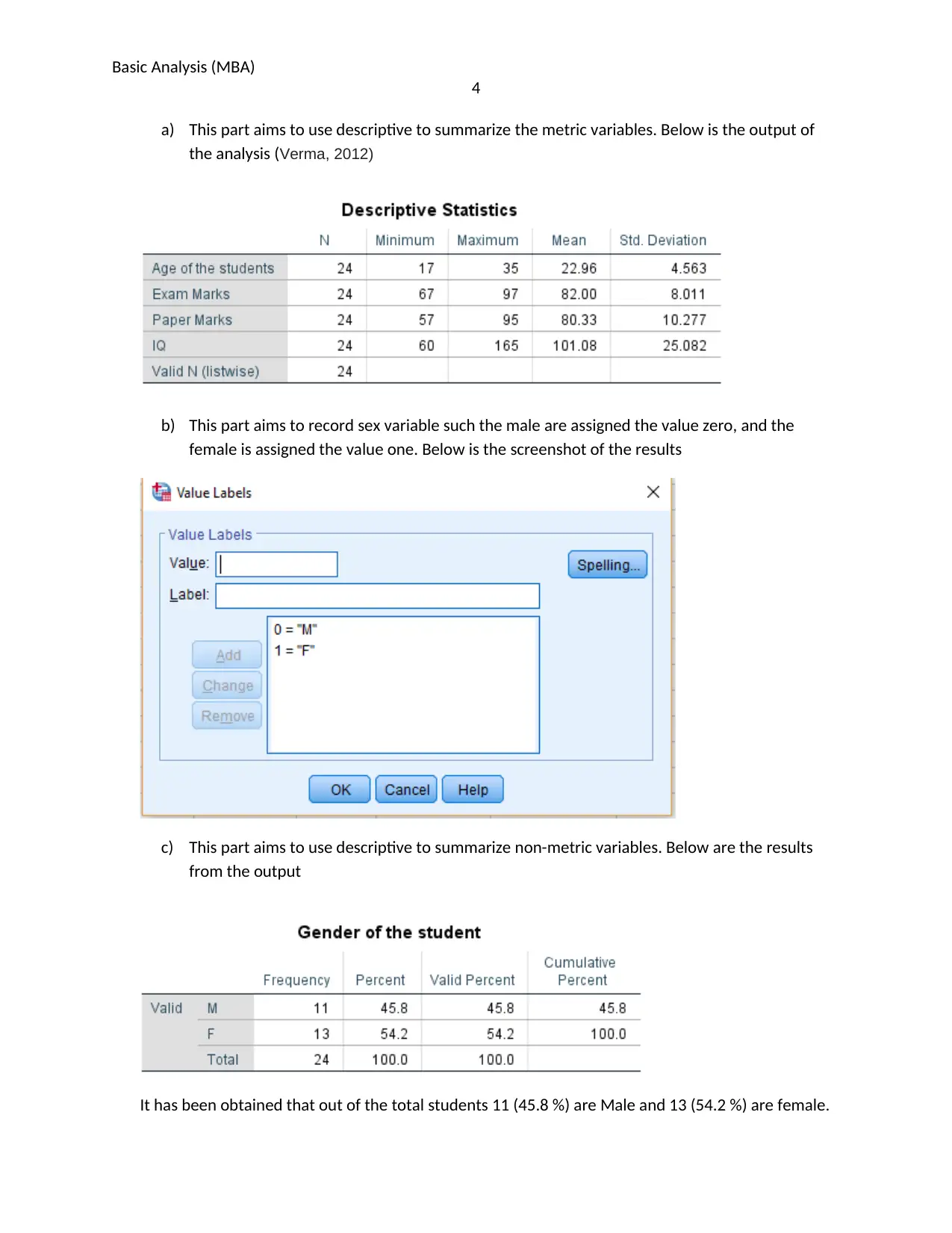
Basic Analysis (MBA)
4
a) This part aims to use descriptive to summarize the metric variables. Below is the output of
the analysis (Verma, 2012)
b) This part aims to record sex variable such the male are assigned the value zero, and the
female is assigned the value one. Below is the screenshot of the results
c) This part aims to use descriptive to summarize non-metric variables. Below are the results
from the output
It has been obtained that out of the total students 11 (45.8 %) are Male and 13 (54.2 %) are female.
4
a) This part aims to use descriptive to summarize the metric variables. Below is the output of
the analysis (Verma, 2012)
b) This part aims to record sex variable such the male are assigned the value zero, and the
female is assigned the value one. Below is the screenshot of the results
c) This part aims to use descriptive to summarize non-metric variables. Below are the results
from the output
It has been obtained that out of the total students 11 (45.8 %) are Male and 13 (54.2 %) are female.
Paraphrase This Document
Need a fresh take? Get an instant paraphrase of this document with our AI Paraphraser
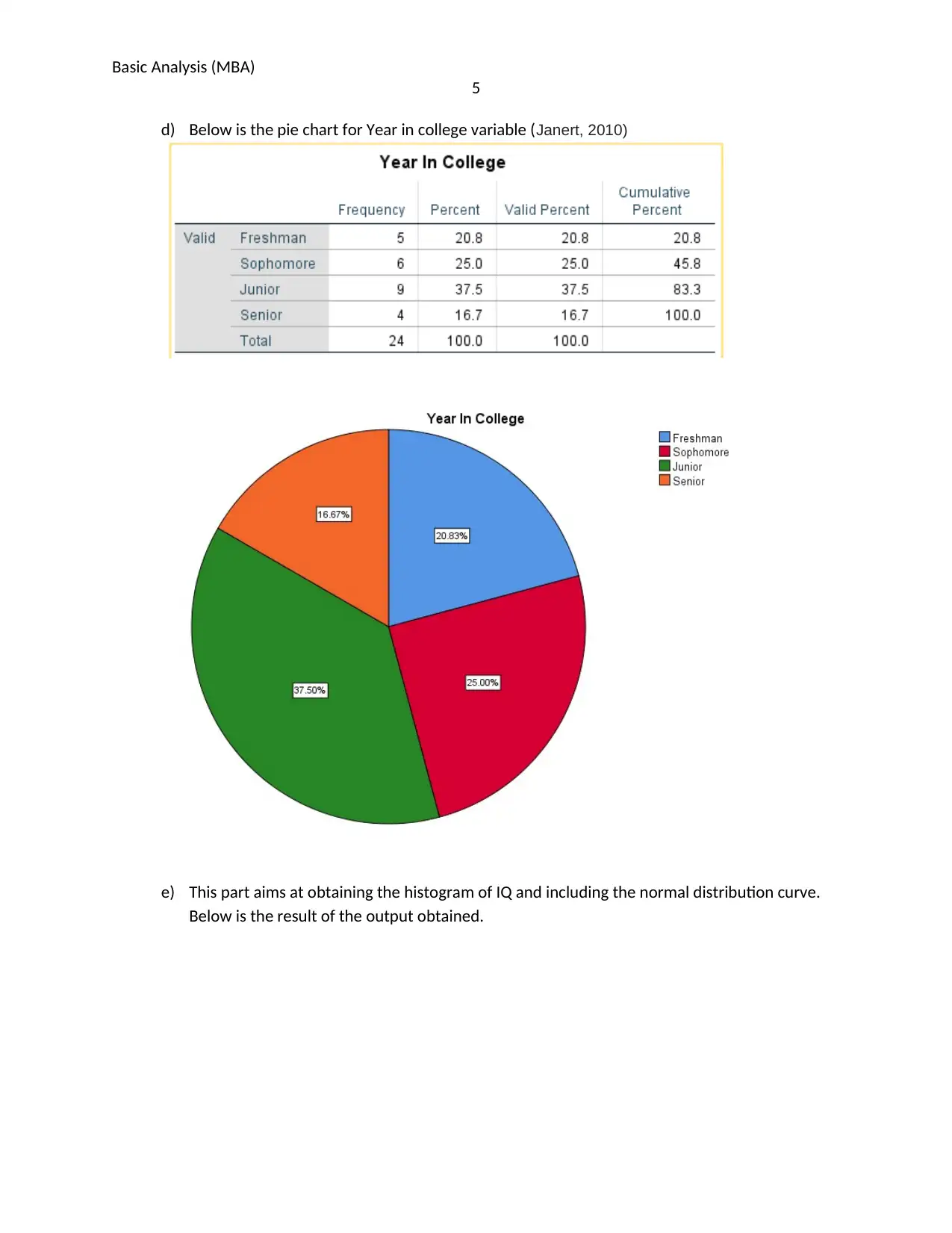
Basic Analysis (MBA)
5
d) Below is the pie chart for Year in college variable (Janert, 2010)
e) This part aims at obtaining the histogram of IQ and including the normal distribution curve.
Below is the result of the output obtained.
5
d) Below is the pie chart for Year in college variable (Janert, 2010)
e) This part aims at obtaining the histogram of IQ and including the normal distribution curve.
Below is the result of the output obtained.
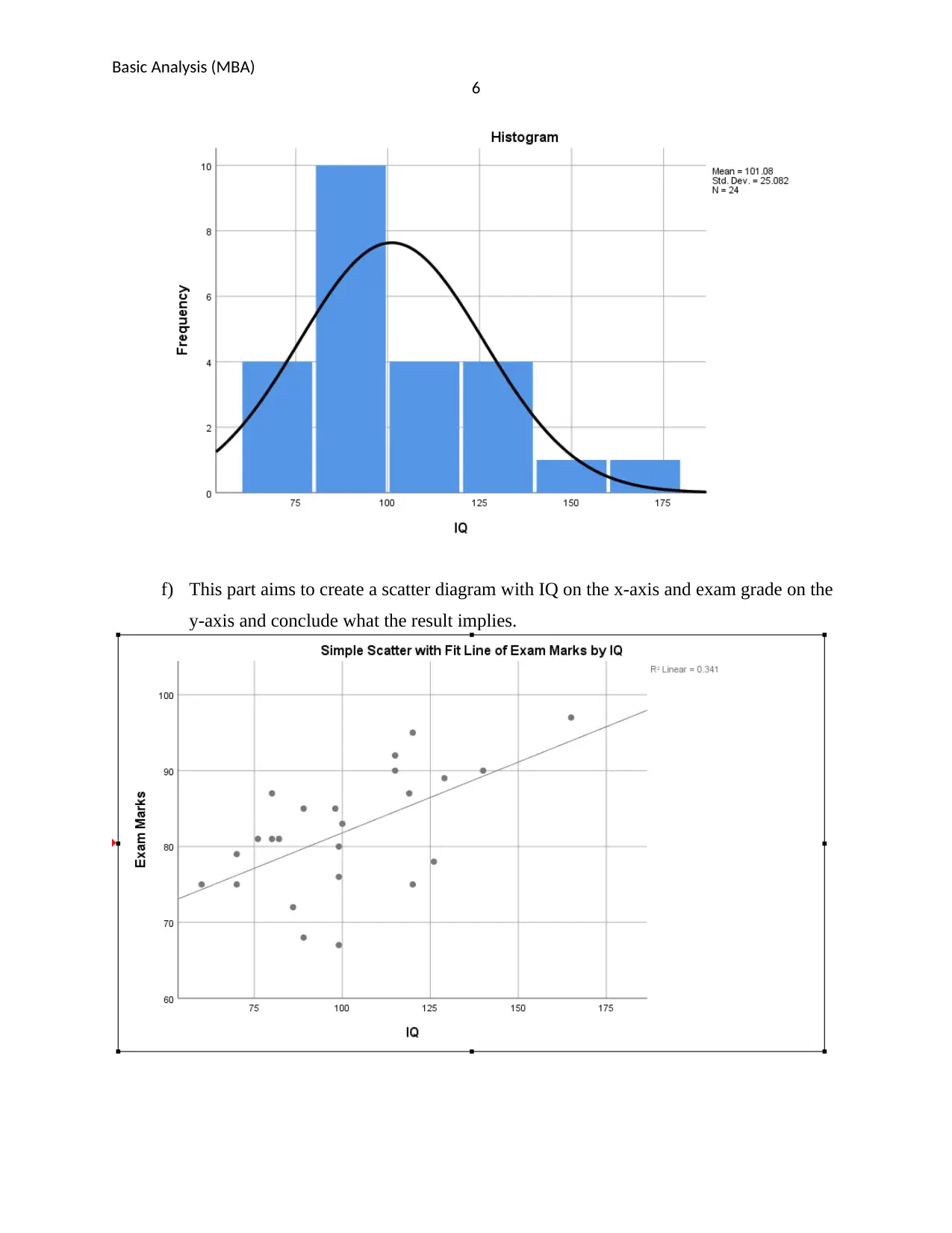
Basic Analysis (MBA)
6
f) This part aims to create a scatter diagram with IQ on the x-axis and exam grade on the
y-axis and conclude what the result implies.
6
f) This part aims to create a scatter diagram with IQ on the x-axis and exam grade on the
y-axis and conclude what the result implies.
⊘ This is a preview!⊘
Do you want full access?
Subscribe today to unlock all pages.

Trusted by 1+ million students worldwide
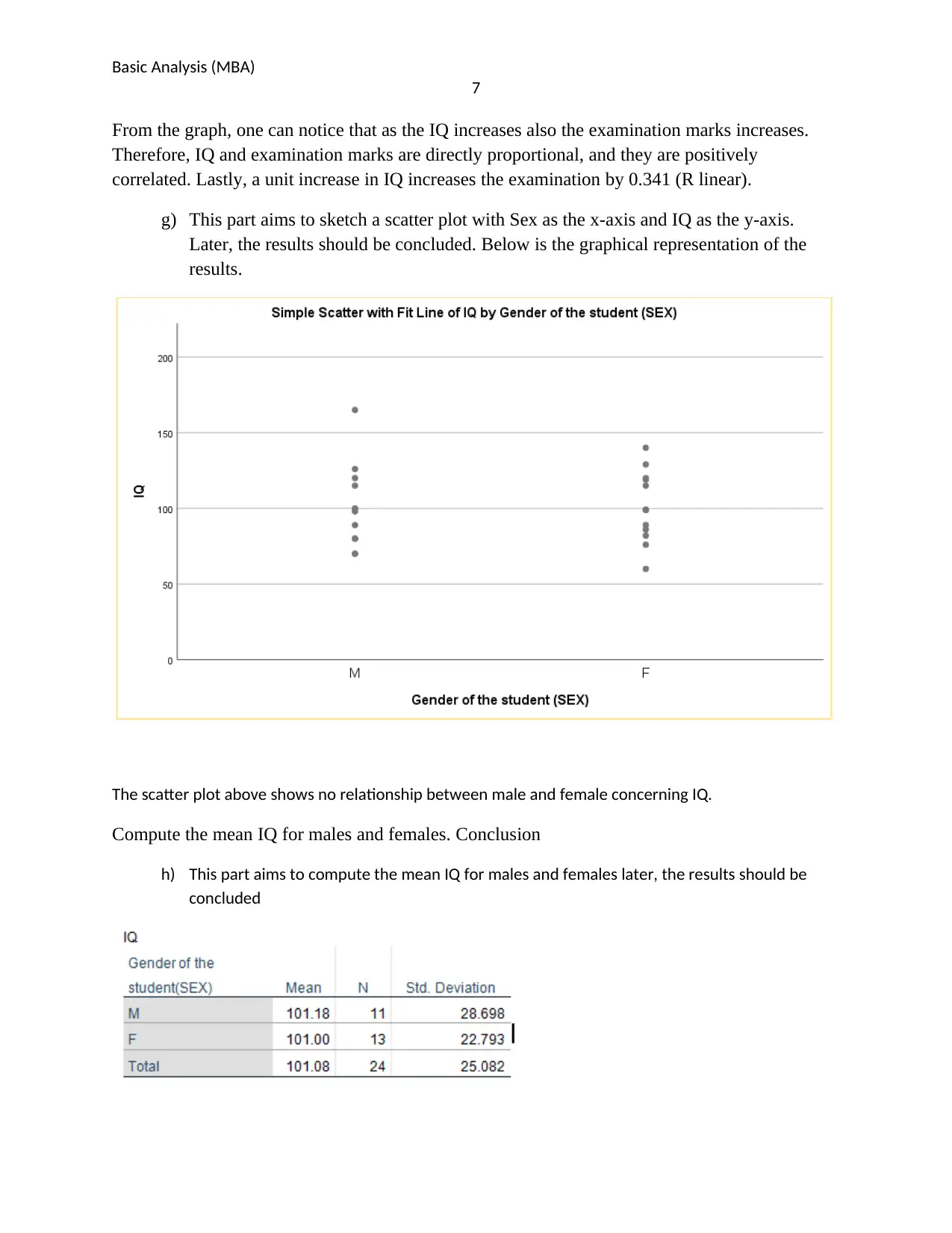
Basic Analysis (MBA)
7
From the graph, one can notice that as the IQ increases also the examination marks increases.
Therefore, IQ and examination marks are directly proportional, and they are positively
correlated. Lastly, a unit increase in IQ increases the examination by 0.341 (R linear).
g) This part aims to sketch a scatter plot with Sex as the x-axis and IQ as the y-axis.
Later, the results should be concluded. Below is the graphical representation of the
results.
The scatter plot above shows no relationship between male and female concerning IQ.
Compute the mean IQ for males and females. Conclusion
h) This part aims to compute the mean IQ for males and females later, the results should be
concluded
7
From the graph, one can notice that as the IQ increases also the examination marks increases.
Therefore, IQ and examination marks are directly proportional, and they are positively
correlated. Lastly, a unit increase in IQ increases the examination by 0.341 (R linear).
g) This part aims to sketch a scatter plot with Sex as the x-axis and IQ as the y-axis.
Later, the results should be concluded. Below is the graphical representation of the
results.
The scatter plot above shows no relationship between male and female concerning IQ.
Compute the mean IQ for males and females. Conclusion
h) This part aims to compute the mean IQ for males and females later, the results should be
concluded
Paraphrase This Document
Need a fresh take? Get an instant paraphrase of this document with our AI Paraphraser
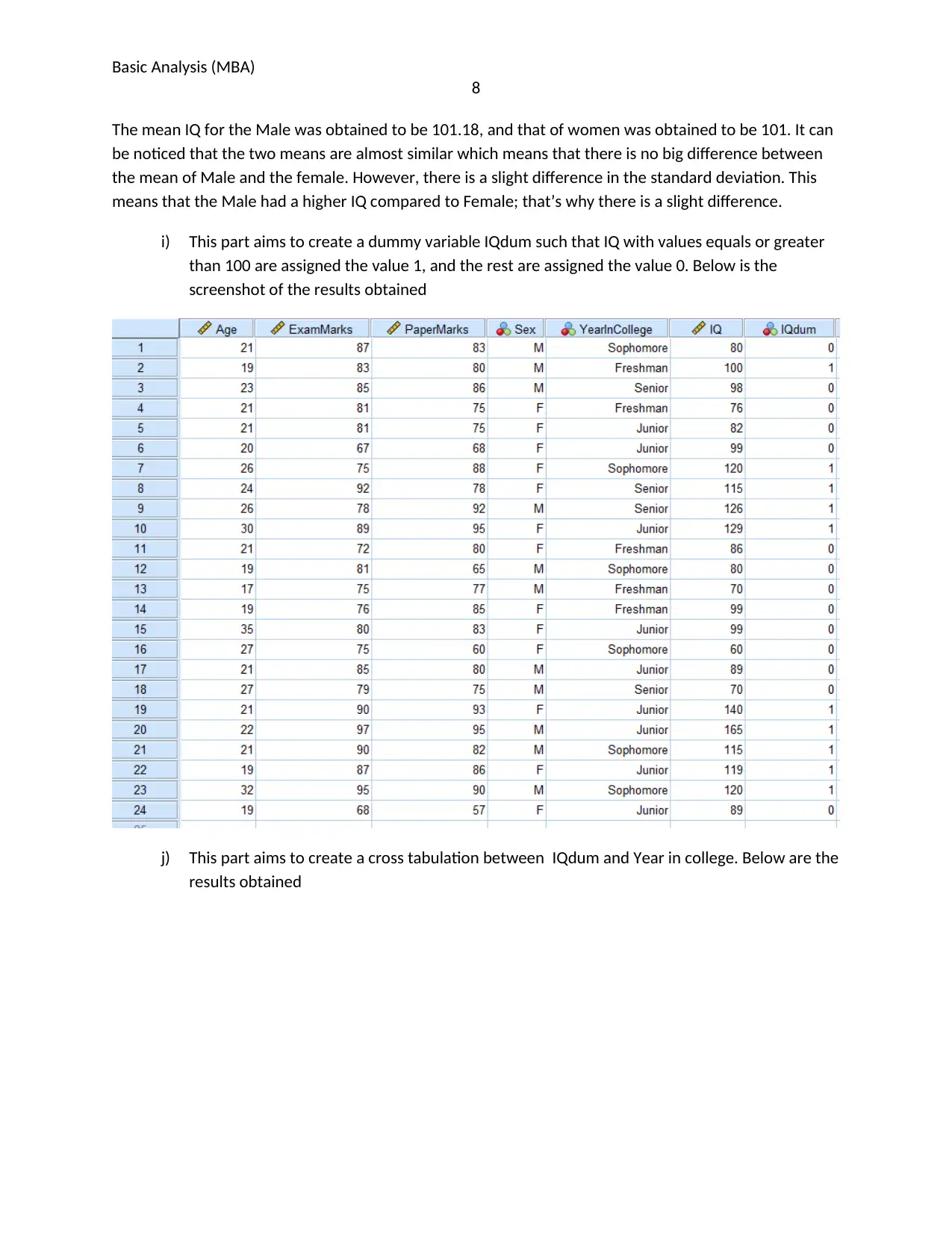
Basic Analysis (MBA)
8
The mean IQ for the Male was obtained to be 101.18, and that of women was obtained to be 101. It can
be noticed that the two means are almost similar which means that there is no big difference between
the mean of Male and the female. However, there is a slight difference in the standard deviation. This
means that the Male had a higher IQ compared to Female; that’s why there is a slight difference.
i) This part aims to create a dummy variable IQdum such that IQ with values equals or greater
than 100 are assigned the value 1, and the rest are assigned the value 0. Below is the
screenshot of the results obtained
j) This part aims to create a cross tabulation between IQdum and Year in college. Below are the
results obtained
8
The mean IQ for the Male was obtained to be 101.18, and that of women was obtained to be 101. It can
be noticed that the two means are almost similar which means that there is no big difference between
the mean of Male and the female. However, there is a slight difference in the standard deviation. This
means that the Male had a higher IQ compared to Female; that’s why there is a slight difference.
i) This part aims to create a dummy variable IQdum such that IQ with values equals or greater
than 100 are assigned the value 1, and the rest are assigned the value 0. Below is the
screenshot of the results obtained
j) This part aims to create a cross tabulation between IQdum and Year in college. Below are the
results obtained
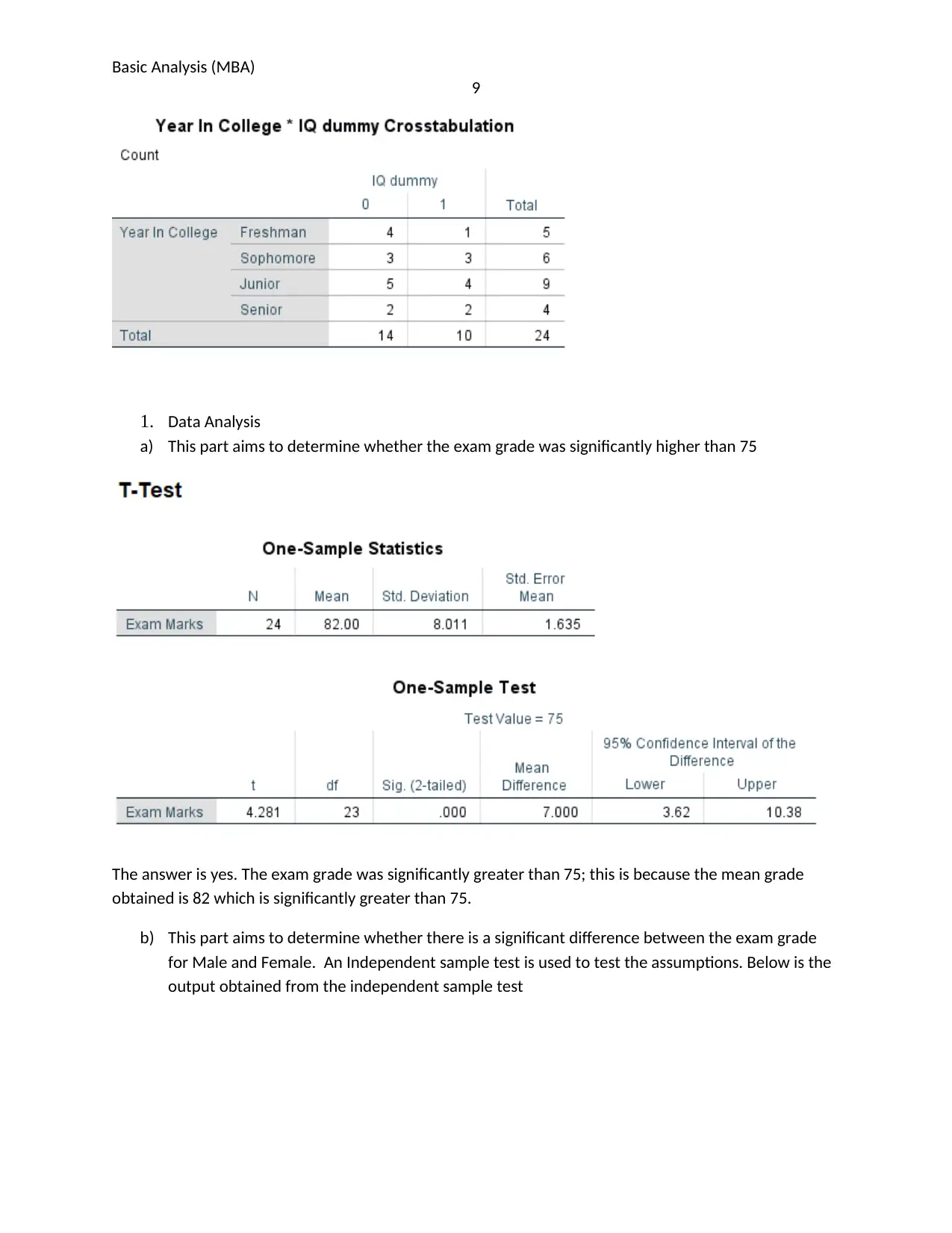
Basic Analysis (MBA)
9
1. Data Analysis
a) This part aims to determine whether the exam grade was significantly higher than 75
The answer is yes. The exam grade was significantly greater than 75; this is because the mean grade
obtained is 82 which is significantly greater than 75.
b) This part aims to determine whether there is a significant difference between the exam grade
for Male and Female. An Independent sample test is used to test the assumptions. Below is the
output obtained from the independent sample test
9
1. Data Analysis
a) This part aims to determine whether the exam grade was significantly higher than 75
The answer is yes. The exam grade was significantly greater than 75; this is because the mean grade
obtained is 82 which is significantly greater than 75.
b) This part aims to determine whether there is a significant difference between the exam grade
for Male and Female. An Independent sample test is used to test the assumptions. Below is the
output obtained from the independent sample test
⊘ This is a preview!⊘
Do you want full access?
Subscribe today to unlock all pages.

Trusted by 1+ million students worldwide
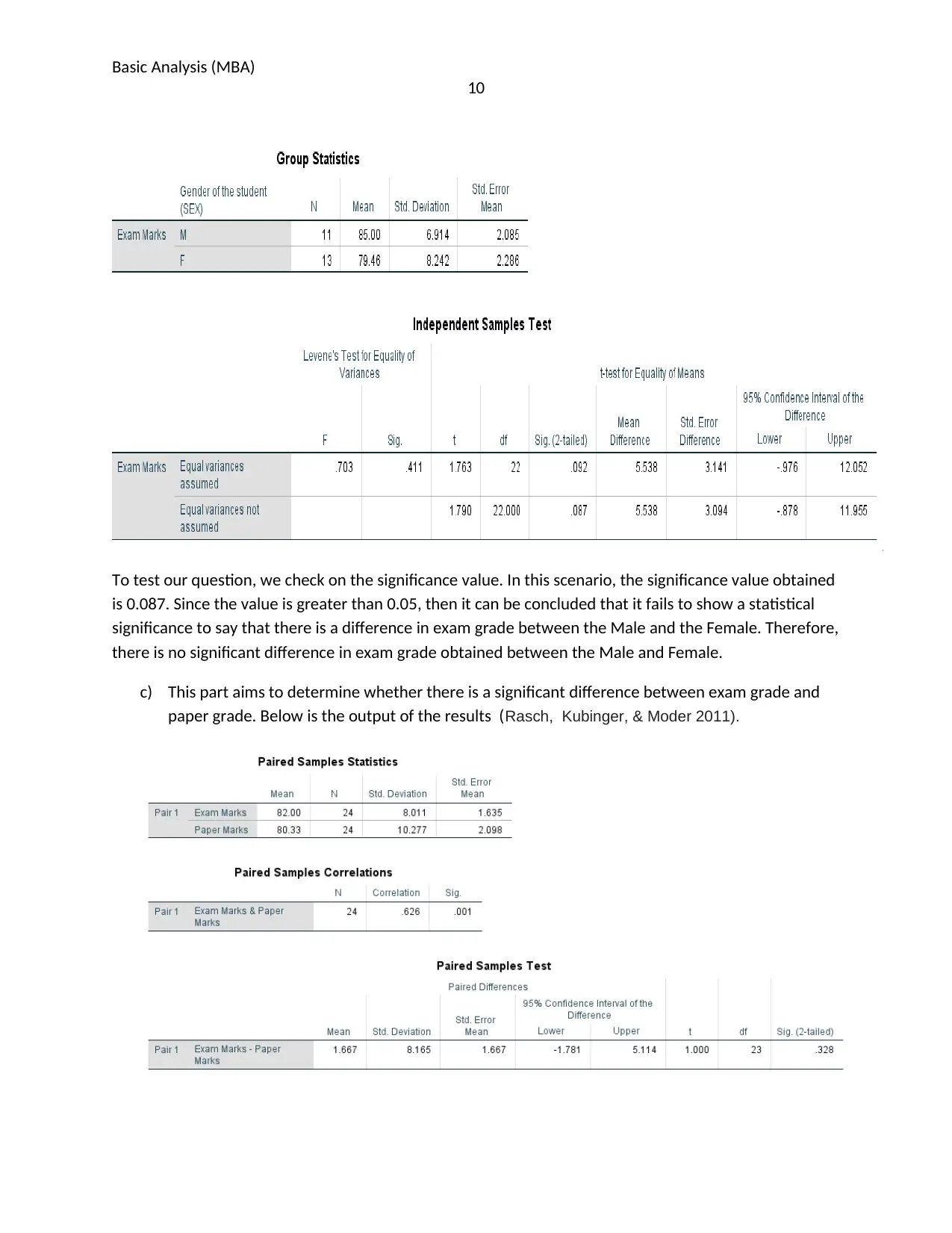
Basic Analysis (MBA)
10
To test our question, we check on the significance value. In this scenario, the significance value obtained
is 0.087. Since the value is greater than 0.05, then it can be concluded that it fails to show a statistical
significance to say that there is a difference in exam grade between the Male and the Female. Therefore,
there is no significant difference in exam grade obtained between the Male and Female.
c) This part aims to determine whether there is a significant difference between exam grade and
paper grade. Below is the output of the results (Rasch, Kubinger, & Moder 2011).
10
To test our question, we check on the significance value. In this scenario, the significance value obtained
is 0.087. Since the value is greater than 0.05, then it can be concluded that it fails to show a statistical
significance to say that there is a difference in exam grade between the Male and the Female. Therefore,
there is no significant difference in exam grade obtained between the Male and Female.
c) This part aims to determine whether there is a significant difference between exam grade and
paper grade. Below is the output of the results (Rasch, Kubinger, & Moder 2011).
Paraphrase This Document
Need a fresh take? Get an instant paraphrase of this document with our AI Paraphraser
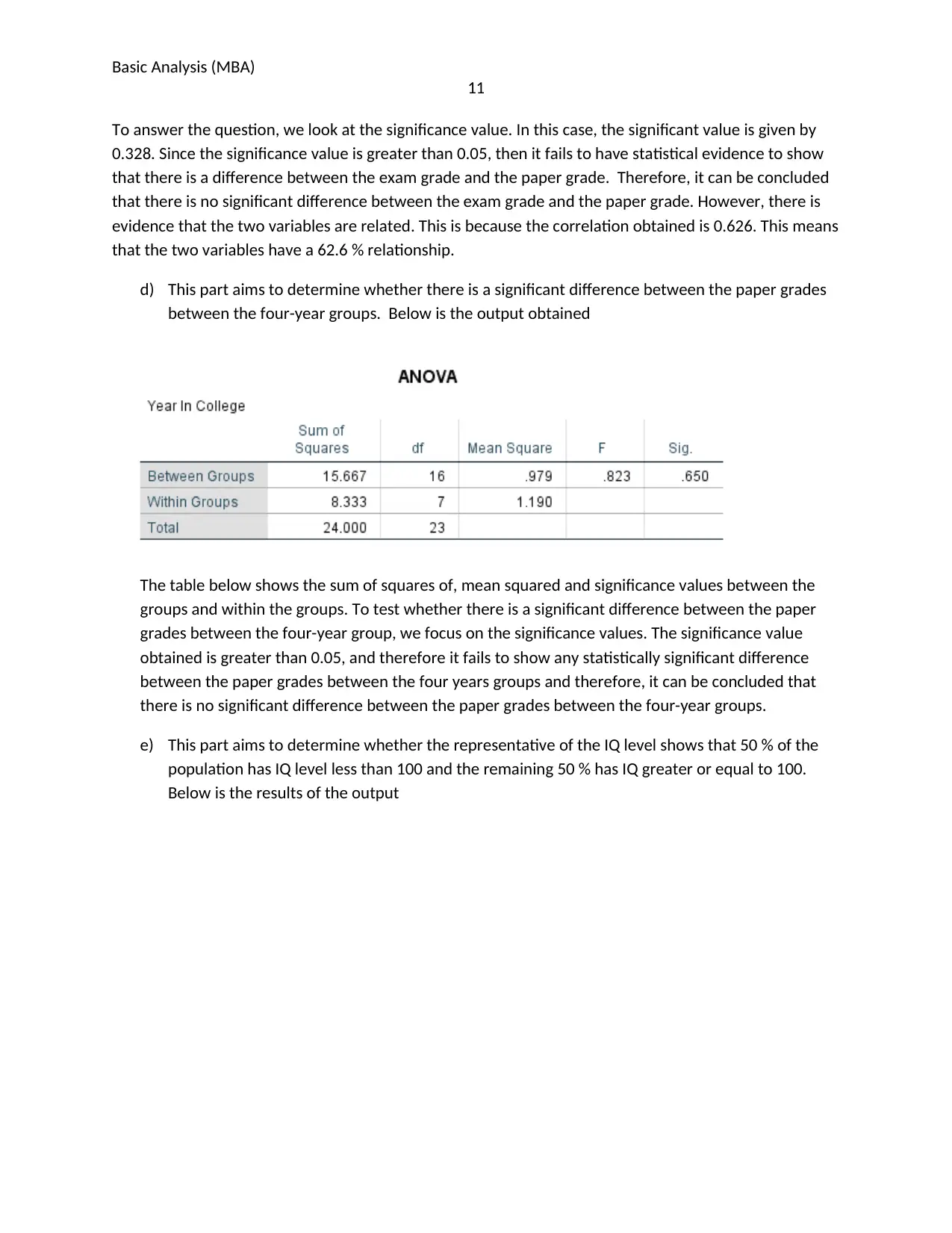
Basic Analysis (MBA)
11
To answer the question, we look at the significance value. In this case, the significant value is given by
0.328. Since the significance value is greater than 0.05, then it fails to have statistical evidence to show
that there is a difference between the exam grade and the paper grade. Therefore, it can be concluded
that there is no significant difference between the exam grade and the paper grade. However, there is
evidence that the two variables are related. This is because the correlation obtained is 0.626. This means
that the two variables have a 62.6 % relationship.
d) This part aims to determine whether there is a significant difference between the paper grades
between the four-year groups. Below is the output obtained
The table below shows the sum of squares of, mean squared and significance values between the
groups and within the groups. To test whether there is a significant difference between the paper
grades between the four-year group, we focus on the significance values. The significance value
obtained is greater than 0.05, and therefore it fails to show any statistically significant difference
between the paper grades between the four years groups and therefore, it can be concluded that
there is no significant difference between the paper grades between the four-year groups.
e) This part aims to determine whether the representative of the IQ level shows that 50 % of the
population has IQ level less than 100 and the remaining 50 % has IQ greater or equal to 100.
Below is the results of the output
11
To answer the question, we look at the significance value. In this case, the significant value is given by
0.328. Since the significance value is greater than 0.05, then it fails to have statistical evidence to show
that there is a difference between the exam grade and the paper grade. Therefore, it can be concluded
that there is no significant difference between the exam grade and the paper grade. However, there is
evidence that the two variables are related. This is because the correlation obtained is 0.626. This means
that the two variables have a 62.6 % relationship.
d) This part aims to determine whether there is a significant difference between the paper grades
between the four-year groups. Below is the output obtained
The table below shows the sum of squares of, mean squared and significance values between the
groups and within the groups. To test whether there is a significant difference between the paper
grades between the four-year group, we focus on the significance values. The significance value
obtained is greater than 0.05, and therefore it fails to show any statistically significant difference
between the paper grades between the four years groups and therefore, it can be concluded that
there is no significant difference between the paper grades between the four-year groups.
e) This part aims to determine whether the representative of the IQ level shows that 50 % of the
population has IQ level less than 100 and the remaining 50 % has IQ greater or equal to 100.
Below is the results of the output
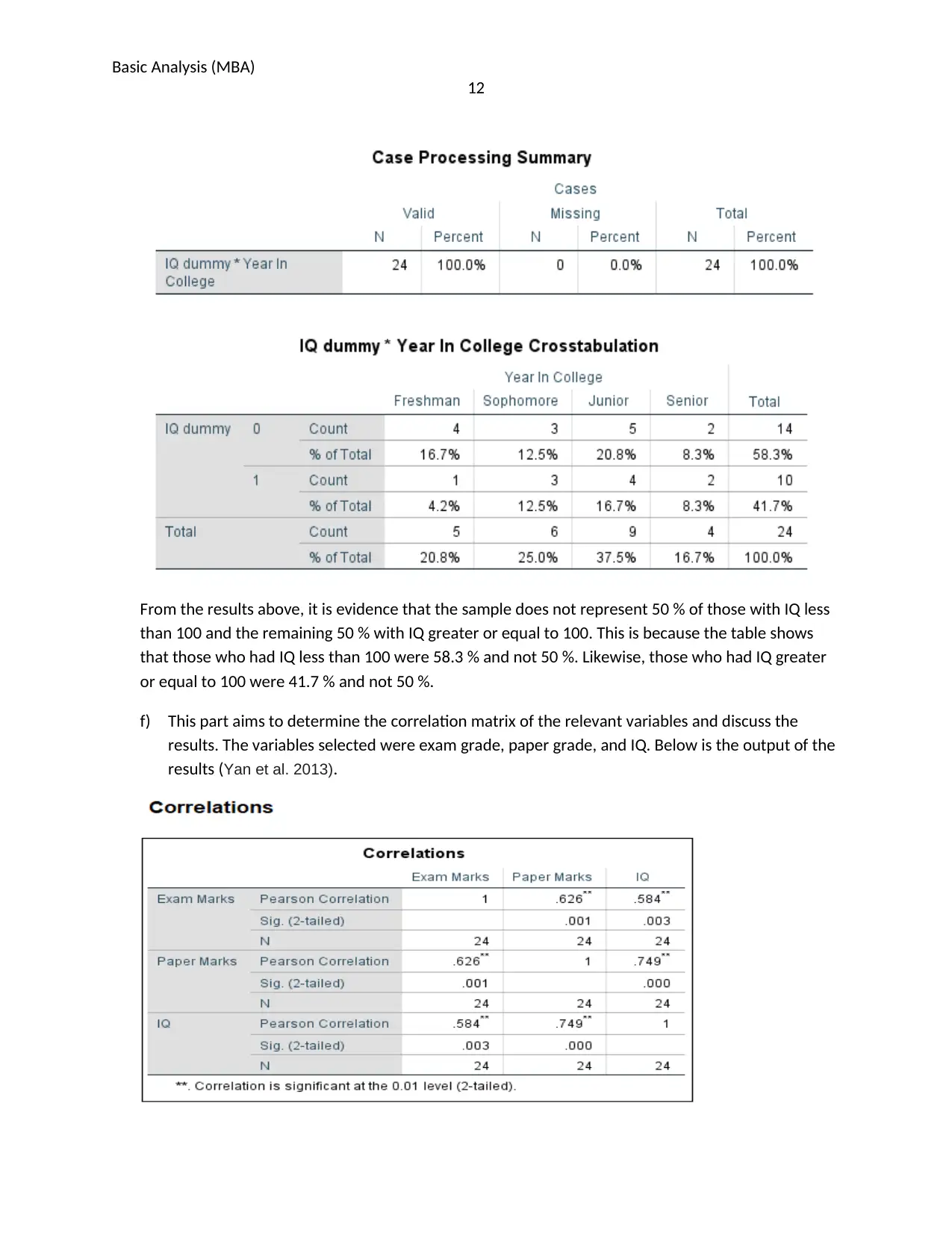
Basic Analysis (MBA)
12
From the results above, it is evidence that the sample does not represent 50 % of those with IQ less
than 100 and the remaining 50 % with IQ greater or equal to 100. This is because the table shows
that those who had IQ less than 100 were 58.3 % and not 50 %. Likewise, those who had IQ greater
or equal to 100 were 41.7 % and not 50 %.
f) This part aims to determine the correlation matrix of the relevant variables and discuss the
results. The variables selected were exam grade, paper grade, and IQ. Below is the output of the
results (Yan et al. 2013).
12
From the results above, it is evidence that the sample does not represent 50 % of those with IQ less
than 100 and the remaining 50 % with IQ greater or equal to 100. This is because the table shows
that those who had IQ less than 100 were 58.3 % and not 50 %. Likewise, those who had IQ greater
or equal to 100 were 41.7 % and not 50 %.
f) This part aims to determine the correlation matrix of the relevant variables and discuss the
results. The variables selected were exam grade, paper grade, and IQ. Below is the output of the
results (Yan et al. 2013).
⊘ This is a preview!⊘
Do you want full access?
Subscribe today to unlock all pages.

Trusted by 1+ million students worldwide
1 out of 15
Related Documents
Your All-in-One AI-Powered Toolkit for Academic Success.
+13062052269
info@desklib.com
Available 24*7 on WhatsApp / Email
![[object Object]](/_next/static/media/star-bottom.7253800d.svg)
Unlock your academic potential
Copyright © 2020–2025 A2Z Services. All Rights Reserved. Developed and managed by ZUCOL.





